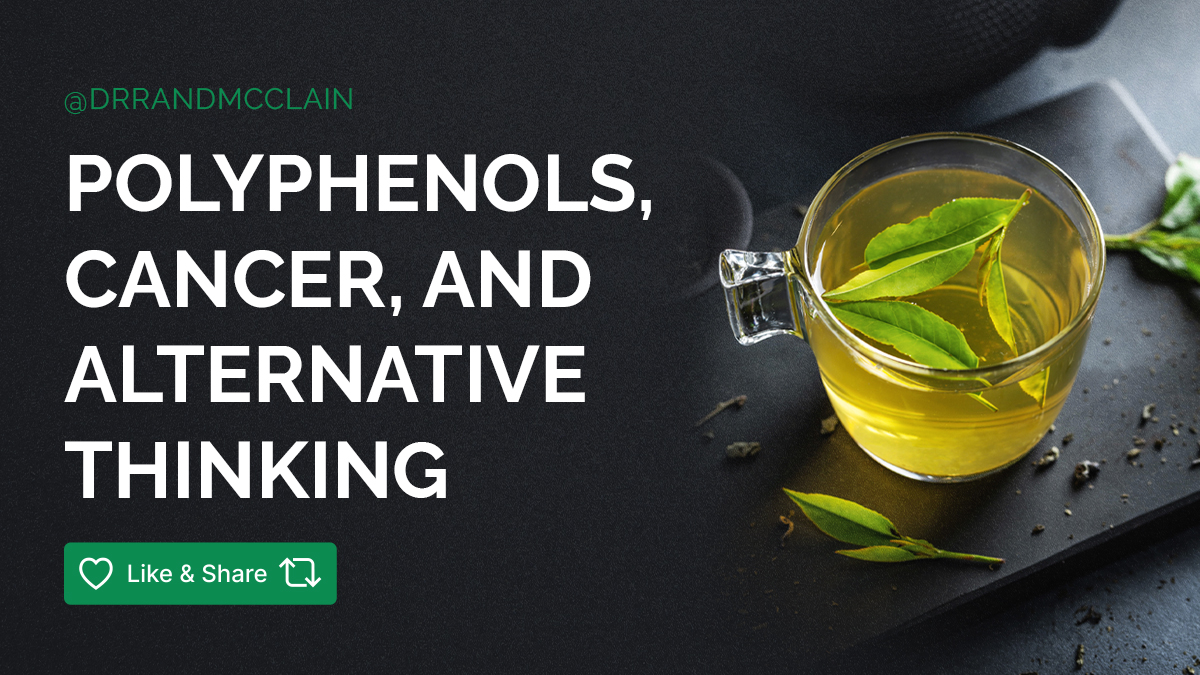Polyphenols, Cancer, and Alternative Thinking

As I’ve mentioned previously, research has linked diets rich in plant foods to a lower risk of cancer, and many experts believe that polyphenols are partly responsible for this. So, let’s focus on one of the most studied polyphenols and what we’ve learned.
Got Green Tea?
As I noted, the polyphenol in green tea is epigallecatechin-3-gallate or EGCG for short. While many studies identify this polyphenol’s anti-cancer effect, let’s look at one particular study, titled, “Cancer prevention trial of a synergistic mixture of green tea concentrate plus Capsicum (CAPSOL-T) in a random population of 110 subjects ages 40-84.” This study was conducted by Claudia Hanau, Dr. James Morre and Dr. Morre’s wife, Dorothy, and one reason the study is notable is that Dr. Morre spent almost 40 years studying ENOX2 proteins and their presence in cancer. I always respect when a study represents a scientist’s life’s work.
These proteins are only found in two places, cancer and fetal development, which is significant from a testing perspective. Dr. Morre developed a test to detect the presence of ENOX2 and called it an ONCOblot Tissue of Origin Cancer Test. In fact, testing the ENOX2’s molecular weight and isoelectric point (pH), the tissue where the cancer originated can also be identified. The test is highly sensitive, able to spot as few as 800,000 cancer cells—that sounds like a big number, but from a physiological standpoint, it’s actually a small one. No other method can identify cancer based on this small number of cells.
Cancer forms when mutating cells begin to grow rapidly and out of control. Cell mutations occur in our bodies all the time, but they don’t become cancers because we have a natural process that destroys these mutations. But when this process fails, cancer starts. In these instances, we still possess the capacity to control and even reverse cancer. But we need to intervene early, and chemotherapy light can be a highly effective intervention, as the Dr. Morre study demonstrates.
More Than a Single Cup
This study also reveals that it takes more than a cup of green tea daily to control or reverse cancer. The amount of green tea concentrate used in the study was the equivalent of 16 cups of green tea. The green tea was combined with concentrated capsaicin to facilitate the polyphenol’s availability to cells, dramatically increasing its cancer-killing power. When they treated patients who were re-tested for the ENOX2 proteins, they were absent, indicating how effective the treatment was.
I’ve used the ONCOblot test in my practice, and it has identified a number of patients with ENOX2 in their blood. We followed up with additional testing, such as a multiparametric MRI for prostate cancer and mammography and biopsy for breast cancer. I also gave myself the ONCOblot test, and to my surprise, I discovered I had ENOX2 proteins in the prostate, and subsequent tests confirmed early-stage cancer. I and the other patients who tested positive underwent 90 to 180 days of treatment with CAPSOL-T use (green tea extract); some of us also combined CAPSOL-T with doses of metformin, depending on the type of cancer and patient circumstances. Some patients also had surgery.

Every patient (including myself) tested negative for ENOX2 proteins after these treatments, and additional, traditional testing confirmed that the cancer was gone.
Proceed with Caution
As positive as I am about polyphenols, I also know that even seemingly “harmless” products such as over-the-counter medicines come with a warning. With polyphenols, the warning has to do with toxicity. Too much of anything can be a bad thing, and liver toxicity is a concern with polyphenols if you take too much or are fasting.
Perhaps more significantly, they also can have overall systemic and cellular toxicity when used as chemotherapy light. Like traditional chemotherapy, polyphenol treatments disrupt DNA beneficially in cancer cells but also in healthy cells. Chemo’s goal is to target cancer cells while sparing (through wounding) healthy cells. Thus, the polyphenol dose needs to be calibrated judiciously. Too high a dose of polyphenols, like too high a dose of traditional chemo, can devastate healthy cells while it’s destroying cancer cells.
Also, not all polyphenols are created equal. Put another way; one polyphenol may be better for a particular type of cancer than another. In addition, one polyphenol may work particularly well with another polyphenol—or you may want to avoid a particular combination because of potential toxicity or one canceling out the effects of another.
In addition, absorption can be a problem with polyphenols. Fortunately, we can improve their bioavailability by combining them with an extract of pepper—an alkaloid extract of the black pepper family (Piper nigrum). We can also combine polyphenols with phospholipids to facilitate absorption.
The good news is that polyphenols aren’t expensive and don’t require prescriptions. They do require consultation with a doctor who has experience using them to treat particular types of cancer to figure out the right ones to use and the doses. From a preventative medicine standpoint, however, everyone can take advantage of their cancer-fighting properties. Empirically, there’s a lot of evidence to suggest that because the French drink so much red wine and the Japanese so much green tea, they have better health and longevity than many other populations.
The Business of Medicine
None of my enthusiasm for polyphenols blinds me to the continued need for surgery, chemo and radiation, especially for advanced forms of cancer. At the same, I’m also aware that the business of medicine causes doctors to be less aware of and enthusiastic about polyphenols as they might be.
There isn’t as much financial incentive for scientists to research anti-cancer treatments using polyphenols as there are for other, more lucrative approaches. At the same time, we’re also seeing greater medical community recognition of alternative methods and the value of naturally occurring chemicals like polyphenols. As someone who began my career studying nutrition, moved on to naturopathic and orthomolecular medicine, studied traditional Chinese medicine and then went to medical school, I’ve witnessed a shift in attitude and practice regarding alternative and complementary methods.
Admittedly, it’s difficult to create credibility for forms of medicine such as acupuncture, where you can’t do the double-blinded, placebo-controlled studies that provide scientific validity. Polyphenols, however, are chemicals that can be studied and should be studied more using rigorous scientific methods.
Interestingly, traditional Chinese medicine and Indian Ayurvedic medicine use herbs and herbal formulations containing polyphenols to fight cancer.
It’s time we become even more open-minded about how we treat the illnesses and disorders that confront us, whether they are viruses, aging-related issues or cancer.